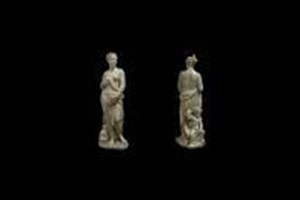
The sculpture was originally in the collection of the noted poet and musician Juan de Arguijo (1567-1623). It was among the objects he kept in his house in Seville where he welcomed figures such as Francisco Pacheco, Pablo de Céspedes, Fernando de Herrera and Alonso Vázquez and where Lope de Vega stayed as a guest.
In addition to its artistic merit, the true significance of this sculpture lies in its connections to the poems of Lope de Vega, which are directly related to it in a most exceptional manner; to the survival of references to the classical world and mythology, and to the nude and secular sculpture, again a rarity in the context of Spanish art.
The sculpture was declared an Item of Cultural Importance by the Comunidad de Madrid and has been acquired with funds from the Museo del Prado itself, which exercised the right to pre-emption in a sale between private parties for the sum of 750,000 Euros.
The sculpture by Giovanni Bandini acquired by the Museo Nacional del Prado depicts a standing Venus based on models of the so-called “Venus Pudica”. Both the body and the head, with its elegant, elaborate hairstyle, are slightly turned to avoid frontality and create a greater sense of dynamism. Bandini’s composition aims to take full advantage of the free-standing nature of sculpture through the inclusion of a dolphin next to the goddess’s right foot, its body functioning at the back of the work as the seat for a small naked Cupid with his traditional quiver who is shown playing with the animal’s tail.
On the base of the work an inscription includes the name of the artist and his place of origin: “IOHES BANDINUS FLORENTINUS F.” Giovanni di Benedetto Bandini da Castello or Giovanni dell’Opera (1540-1599) was one of the key figures in the Tuscan art world of the second half of the 16th century and a pupil of Baccio Bandinelli. In his celebrated work Il Riposo of 1584 Raffaello Borghini provided information on the artist’s output.
Bandini worked on the marble reliefs designed by Bandinelli for the choir of Santa Maria dell’Fiore. He also produced a number of portraits and participated in a project of long-lasting symbolic significance directed by Giorgio Vasari, namely the tomb of Michelangelo in the church of Santa Croce, executing the sculpture of the allegory of Architecture.
Borghini also provides the important information that Bandini worked with great skill on a bronze group on a hunting theme, rendered in great detail, as a commission for the Duke of Urbino which would ultimately be employed as a diplomatic gift to the future Philip III of Spain and is now in the Museo del Prado with the title of The Hunt.
It is possible to establish a connection between that work in bronze and the sculpture of Venus and Cupid with regard to the artist’s intention to take full advantage of the merits of sculpture as a reproduction of reality. Expressing the work’s volume to the greatest possible extent allowed for the possibility of multiplying the viewpoints at a time when the debate on the paragone between the arts heights was at its height.
Venus and Cupid was originally in the collection of the poet and musician Juan de Arguijo (1567-1623) and was among the objects which he kept in his house in Seville, destroyed in 1914, on present-day calle de Laraña opposite the church of the Anunciación. Arguijo’s house was the venue for informal debates and a literary academy. It was visited by figures such as Francisco Pacheco, Pablo de Céspedes, Fernando de Herrera and Alonso Vázquez while Lope de Vega stayed there as a guest. The latter not only referred to Arguijo in eulogistic terms but also dedicated some of his poems to him.
It was in this context that the sculpture of Venus and Cupid arrived at the poet’s house. In 1914 Gestoso y Pérez published two photographs of the work by the time it was in Madrid in the house of the Viscount of Irueste, husband of María Manuela O’Neill and son-in-law of the Marquis of La Granja, heir to the entailed estate that included Arguijo’s properties. This was the period when a connection was established with the sonnet that Lope de Vega included in his book The Beauty of Angelica together with various other poems, dedicated to “don Juan de Arguijo Veintecuatro de Sevilla” and published in 1602. The poem, entitled “To don Juan de Arguijo, contemplating an Adonis, Venus and Cupid in marble”, refers to the sculpture’s arrival from Genoa.

ArtDependence Magazine is an international magazine covering all spheres of contemporary art, as well as modern and classical art.
ArtDependence features the latest art news, highlighting interviews with today’s most influential artists, galleries, curators, collectors, fair directors and individuals at the axis of the arts.
The magazine also covers series of articles and reviews on critical art events, new publications and other foremost happenings in the art world.
If you would like to submit events or editorial content to ArtDependence Magazine, please feel free to reach the magazine via the contact page.